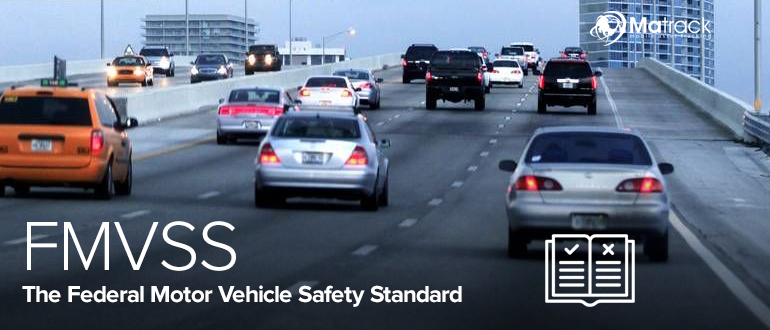Key Takeaways
- FMVSS are safety rules made by NHTSA to keep vehicles safe in the U.S.
- These rules focus on crash prevention, passenger protection, and safety after accidents.
- Vehicles must pass strict tests to meet FMVSS standards before being sold.
- FMVSS helps make vehicles safer, reduces accidents, and builds trust in their safety.
What are the Federal Motor Vehicle Safety Standards (FMVSS)?
The Federal Motor Vehicle Safety Standards (FMVSS) are a set of rules created by the National Highway Traffic Safety Administration (NHTSA). These rules make sure vehicles are safe and meet performance standards in the U.S.
FMVSS helps prevent crashes, protect people in accidents, and improve safety after a crash. It applies to all vehicles and important parts like brakes, airbags, and lights.
What are the different FMVSS safety categories?
The Federal Motor Vehicle Safety Standards (FMVSS) are divided into four groups: Crash Avoidance, Crashworthiness, Post-Crash Survivability, and Miscellaneous. Each group focuses on specific rules to make vehicles safer and more reliable.
Crash avoidance standards
- FMVSS 101 – Controls and Displays: Ensures vehicle controls are clearly visible both day and night to avoid driver mistakes.
- FMVSS 102 – Transmission: Set rules for safe shifting and braking in automatic transmissions to prevent issues like jerky shifts.
- FMVSS 103 – Windshield Defrosting: Requires systems to remove fog from the windshield for better visibility.
- FMVSS 104 – Windshield Wiping: Ensures wipers clear enough of the windshield for safe driving in bad weather.
- FMVSS 105 – Brake Systems: Makes sure hydraulic and electric brakes are reliable and work well in emergencies.
- FMVSS 106 – Brake Hoses: Set standards for durable brake hoses to prevent failures that could lead to accidents.
Crashworthiness standards
- FMVSS 201 – Interior Impact Protection: Requires vehicles to protect occupants’ heads during crashes.
- FMVSS 202 – Head Restraints: Ensures headrests reduce neck injuries during rear-end collisions.
- FMVSS 203 – Steering Impact Protection: Sets standards to minimize injuries from the steering wheel in crashes.
- FMVSS 204 – Steering Displacement: Limits how far the steering column moves in crashes to protect passengers.
- FMVSS 205 – Glazing Materials: Requires strong glass to reduce injuries and stop passengers from being thrown out in crashes.
- FMVSS 206 – Door Locks: Ensures doors stay closed during accidents to keep passengers safe.
Post-crash survivability standards
- FMVSS 301 – Fuel System Integrity: Prevents fuel leaks in crashes to reduce fire risks.
- FMVSS 302 – Interior Flammability: Ensures materials inside vehicles are fire-resistant to prevent fires.
- FMVSS 303 – CNG System Integrity: Sets rules to keep compressed natural gas systems safe in crashes.
- FMVSS 304 – CNG Container Integrity: Ensures gas containers are strong and safe during accidents.
- FMVSS 305 – Electric Vehicle Safety: Protects against battery leaks and electric shocks in electric vehicle crashes.
Miscellaneous standards
- FMVSS 401 – Interior Trunk Release: A trunk release is required to prevent people from getting trapped inside.
- FMVSS 403 – Platform Lifts: Set rules for lifts to safely transport people with mobility aids.
- FMVSS 404 – Platform Lift Installation: Ensures lifts are installed correctly to prevent accidents.
- FMVSS 500 – Low-Speed Vehicles: Requires basic safety features like lights, mirrors, and wipers for vehicles with speeds of 20–25 mph.
Importance of FMVSS Regulations
Enhances Vehicle Safety
FMVSS sets strict rules to make vehicles safer, helping to reduce accidents and save lives. For example, requiring airbags (FMVSS 208) has prevented many fatalities.
Promotes Consumer Trust
When vehicles follow FMVSS standards, buyers know they meet safety requirements, which builds trust in the brands.
Encourages New Technology
These regulations push car makers to use advanced safety features like crash prevention systems and improve electric vehicle safety.
Creates Consistency
FMVSS ensures all vehicles in the U.S. follow the same safety rules, making compliance easier for manufacturers.
Compliance and Testing
Before selling vehicles in the U.S., manufacturers must prove they meet all FMVSS standards. This is done through testing and providing proper documentation to verify compliance.
Testing Procedures:
- Crash Testing: Tests are done to simulate real accidents like front, side, and rollover crashes to check how well passengers are protected.
- Component Testing: Parts like seat belts, lights, and tires are tested individually to make sure they work safely and reliably.
- Environmental Testing: Systems like brakes and electronics are checked to ensure they work properly in extreme weather or tough conditions.
Non-Compliance Penalties:
If a manufacturer doesn’t meet FMVSS standards, they can face large fines, recalls, or damage to their reputation. As of 2025, fines can be as high as $22,723 for each vehicle that doesn’t comply.
Conclusion
The Federal Motor Vehicle Safety Standards (FMVSS) help reduce accidents and protect people by focusing on key safety areas like crash prevention and occupant protection. These standards make vehicles safer and more reliable.
Every vehicle sold in the U.S. must follow FMVSS rules and pass safety tests. These regulations save lives, promote innovation, and ensure all vehicles meet consistent safety standards.
Frequently Asked Questions
What is FMVSS 302?
FMVSS 302 sets fire-resistance standards for materials inside vehicles to reduce fire risks caused by sources like matches or cigarettes.
What is FMVSS Certification?
FMVSS certification verifies that a vehicle or component complies with U.S. federal safety standards through testing and documentation.
What is the difference between CMVSS and FMVSS?
CMVSS applies in Canada, while FMVSS applies in the U.S. Both have similar safety goals but differ in specific standards and compliance requirements.
How does FMVSS improve crash protection?
FMVSS includes standards like airbags, head restraints, and steering impact protection to minimize injuries during collisions.
What is FMVSS 208, and why is it important?
FMVSS 208 focuses on occupant crash protection, requiring features like airbags and seat belts to reduce fatalities and injuries during accidents.



